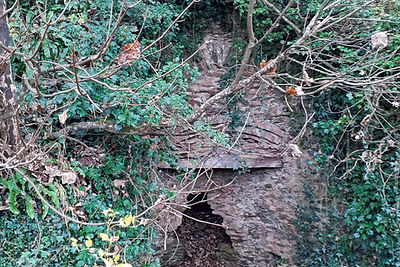Preservation of an historic limekiln
This project preserved an historic limekiln in Lower Aisholt and created public access and interpretation.
Aisholt
QH1011: 01/02/2022 - 31/03/2022; £2,450
QH2017: 01/05/2022 - 31/06/2022; £750
QH2022: 22/08/2022 - 01/12/2022; £17,090.10
QH2029: 19/01/2023 - 01/03/2023; £5,288.40
QH3036: 18/04/2023 - 31/05/2023: £6,202.35
Total FiPL grant: £31,780.85

This project has preserved an historic limekiln in Lower Aisholt and created public access and interpretation. Limekilns were once common in the Quantocks landscape, although most now surviving are in a state of disrepair. Limestone was burned in alternating layers with coal or wood fuel, heating the stone to around 900°C, to produce quicklime which was used for mortar, plaster and limewash, and also spread on agricultural fields to correct acidity.
This limekiln was constructed in the 17 th century and was last used around 1930. It had been suffering from structural degeneration due to invasive tree roots and, despite being sited along a road and popular walking route, was rarely noticed due to scrub encroachment. The applicant wanted to prevent further decline of the kiln, repair the structure, and promote it for public enjoyment and education. Due to the complex nature of the project, it was decided to approach it in stages.
In Phase 1, FiPL supported the removal of the trees and scrub that were threatening the structure, making it safe to access and allowing inspection by a structural engineer.
Phase 2 commissioned the engineer to report on the limekiln’s condition and prepare a specification of works for its preservation.
The main structural works were undertaken in Phase 3, which required partial deconstruction of the wing walls, down to a level where the old mortar was firm, then rebuilding with the original stones and repointing according to traditional methods, using lime mortar. Similarly, a section of the inner lining of the kiln chamber that had collapsed due to tree root invasion needed to be reconstructed. During Phase 3, it was found that the kiln floor was lower than previously understood, and excavations revealed the original grate supports and stoke hole. In the late 1960s, an unfortunate Jersey cow fell into the kiln. A hole was smashed in the front of the structure to extricate her safely, and this has been left unrepaired to preserve this event in the kiln’s history.
Phase 4 installed a safety grid over the top hole to prevent such accidents in the future, and security grids in the stoke hole and grate to ensure that public access can be provided safely.
Finally, Phase 5 enabled public enjoyment of the site, installing seating, fencing, and information boards which will greatly enhance the local network of footpaths and engage the public with the agri-industrial heritage of the Quantocks landscape.
The applicant said: “ The project was not one of economic benefit for the farm business, so not an obvious enterprise to embark upon in these times of falling farm income. However, it was the availability of some financial support from the FiPL scheme that made the difference between this preservation project happening or not. Hopefully the preserved structure will be of public interest, as an historic monument for current and future generations to see. It will have heritage value and serve to increase public awareness of how the resources in our countryside, have been used, and continue to be used, to meet the needs of the times, throughout history. Having support funding channelled via the National Landscape officers, with an understanding of local circumstances, has meant the project has progressed in a logical, cost effective and timely manner”

